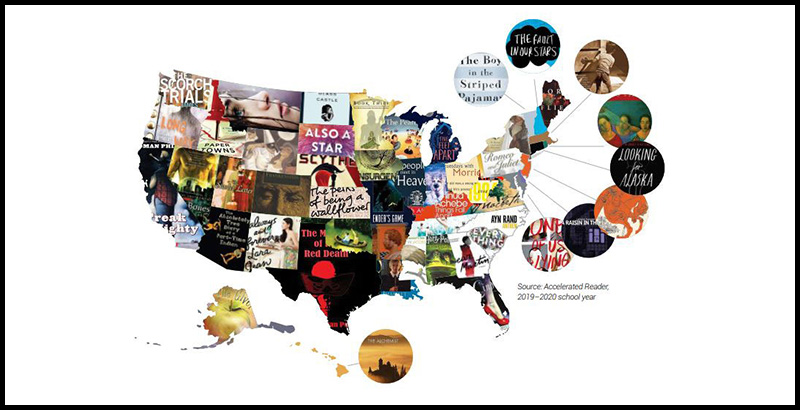Analysis: What Are Students’ Favorite Books? Did COVID-19 Change Their Reading Habits? Annual Report on 7 Million Kids Has Some Answers

Get essential education news and commentary delivered straight to your inbox. Sign up here for The 74’s daily newsletter.
In this year of distance learning, keeping track of how much students are reading has been a challenge for teachers and for parents who became temporary educators. This year’s What Kids Are Reading report looked at the reading habits of 7 million students from more than 26,000 schools in all 50 states and the District of Columbia — and found some good news. Our study, the largest, most comprehensive of its kind, revealed that those students read more than 255 million books last year. Needless to say, as with everything this year, the results were anything but typical.
The first bit of good news is that digital reading increased 107 percent from fall 2019 to fall 2020. Of course, much of this increase was driven by the conditions imposed by the pandemic. When school buildings began to close last spring, one of the first questions educators started asking was, “How can I get books to kids?” Between the shuttered schools and the closed libraries, there were not many options left. As a result, educators made a rapid pivot to digital reading, and the number of hours students read digitally increased from 4.3 million in fall 2019 to 8.9 million in fall 2020. To estimate the number of nondigital books students read, I can report the number of quizzes they took in the Accelerated Reader reading management system. Accelerated Reader quizzing declined from 271 million in 2018-19 to to 255 million in 2019-20, suggesting there may have been a decline in nondigital reading, likely due to an inability to access text.
There is more good news from the quizzes analyzed in the report, though: Students are still reading at the same difficulty level and comprehending just as much as in previous years. This year’s fifth-graders, for example, are reading texts just as difficult as last year’s fifth-graders, and they are comprehending what they are reading at a similar level, despite experiencing greater disruption to their learning as at any time in recent memory.
Schools across the country have worked hard to close the digital divide because of the pandemic, so access to digital books has increased nationwide. For example, in March 2020, 4.2 million kids were on the myON reading platform, and in March 2021, 7.2 million were.
This increase has, in turn, helped educators find books students love. This year, for example, a lot of kids are reading about Kamala Harris. She’s been in the news a great deal, and young people are interested in reading about the first female vice president.
The most-read books aren’t always pegged to current events, however. The most popular digital book for kindergartners was Harrison P. Spader, Personal Space Invader, while Ann Fights for Freedom: An Underground Railroad Survival Story topped the list for sixth-graders. A popular high school title this year, Cracking the Bell, is about a successful high school athlete with a scholarship coming his way and a life that revolves around football. He gets knocked out cold in a game and realizes life is more than just football.
Some longer-term trends continued in this year’s data, namely the decline in independent reading as students progress beyond grades 5 and 6, which has been observed for decades. Reading typically peaks in grades 5 and 6, at more than 370,000 words, yet barely rises above 277,000 words in any grade in high school. This translates into more than 13 minutes of daily reading, then that drops to less than 4 minutes by high school.
Another, more positive, long-term trend is the increase in nonfiction reading. This began when the Common Core State Standards came along and has grown each year since. We expect that to continue, and that’s a good thing. The names, dates and places students absorb by reading nonfiction are the kinds of background information they need to inform all the other reading they do.
Why is it important to know what kids are reading? It is useful to keep track of which books are popular with kids in their independent reading time because students who are interested in what they are reading read more and become more fluent in their reading. Titles that are widely popular become ideal books to recommend to reluctant readers.
To help teachers and parents find new books their students will love reading, the What Kids Are Reading report includes popular book maps for each grade band and state, along with popular Spanish titles and popular book lists by topics such as fantasy/imagination, animals and interpersonal relationships.
A persistent challenge noted by teachers and parents is that, beginning around fifth grade, boys generally do not read as much as girls, do not read as well and are more likely to be labeled as reluctant or resistant readers. One common issue is that they cannot find books that interest them. These maps and lists can help a fifth-grade teacher in, say, Ohio find the most popular books among fifth-grade boys in that state. She can then share this list with the boys in her class, showing them the books their friends are reading.
This year, it is difficult to talk about anything without acknowledging the disruptions caused by the pandemic and social unrest. For both parents and teachers, pointing kids toward books that address these issues in an age-appropriate way is a powerful first step in helping them become not only better readers, but more informed citizens.
Dr. Gene Kerns (@GeneKerns) is vice president and chief academic officer at Renaissance. He is a third-generation educator and has served as a public school teacher, adjunct faculty member, professional development trainer, district supervisor of academic services and academic adviser at one of the nation’s top edtech companies.
Help fund stories like this. Donate now!

;)